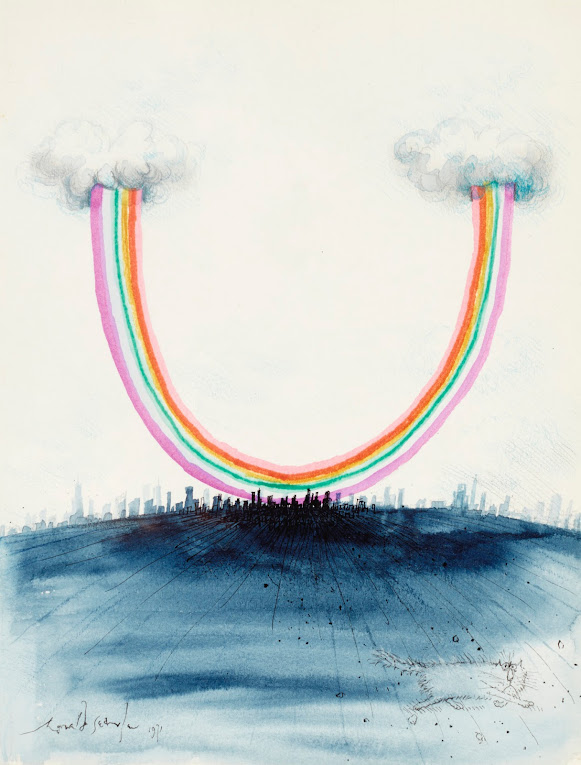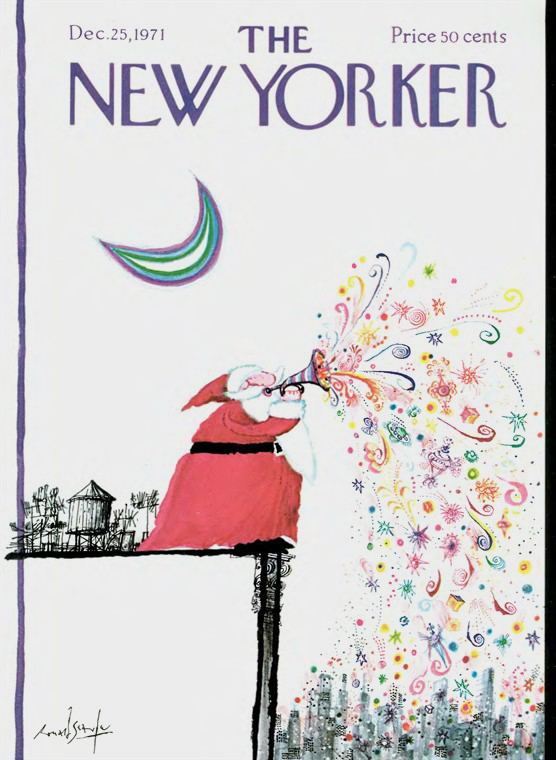The son of a railwayman, Ronald Searle was born in Cambridge on 3 March 1920, and educated in the town at the Boys' Central School. He started work as a solicitor's clerk, and then joined the hire purchase department of the co-operative Society, studying in the evenings and later full-time at the Cambridge Daily News from the age of fifteen.
This resulted in his first cartoon for Lilliput, published in October 1941, and later developed into one of his most famous creations, through a series of books and their cinematic spin-offs. Remarkably, he survived the horrific experiences of the Changi Camp, Singapore as a Japanese prisoner-of-war and managed to produce a visual record of life in a prison camp.
On his return to England in 1945, he exhibited the surviving pictures at the Cambridge School of Art, and published Forty Drawings. The exhibition and volume together established his reputation as one of Britain's most powerful draughtsmen, and led to several opportunities to record the atmosphere of post-war Europe. He contributed to Punch and these drawings crystallised in, The Female Approach (1949). Throughout the fifties, he produced a large variety of illustrations, which together seemed present a guide to life in Britain in the 1950's.
Such was his success that his rejection of family and country in a move to Paris in 1961 came as a great surprise. However, it offered a fresh start, resulting in several solo shows, including a major exhibitions at the Bibliotheque Nationale, Paris, the Berlin-Dahlem Museum and the Wilhelm-Busch-Museum, Hanover. He also reached a new audience with his contributions to film and television, most notably The Magnificent Men in their Flying Machines (1965).
Note: Searle did too many works to post in one series, so I am posting them in two separate series: 1940-1960, and 1961-2007.
For a more detailed biography see part 1, and for earlier works, see parts 1 - 13 (series 1) & parts 14-18 (series 2)
This is part 19 of a 26-part series on the works of Ronald Searle:
1970 The Second Coming of Toulouse-Lautrec: published by Weidenfeld and Nicolson, London:
1970 The Secret Sketchbook: The Backstreets of Hamburg published by Littlehampton Book Services Ltd:
1971 The Addict by Ronald Searle, published by Dobson Books, London.
Wilhelm Busch – Deutsches Museum für Karikatur und Zeichenkunst © The Ronald Searle Cultural Trust:
1972 The Suicide & Reincarnation of an Extremely Small Man published by Daily–Bul in La Louvière, Belgium:
 |
| The New Yorker June 27 1970 |
 |
| The New Yorker September 19 1970 |
 |
| c1970 Circus Horse 42.7 x 31.1 cm Wilhelm Busch – Deutsches Museum für Karikatur und Zeichenkunst © The Ronald Searle Cultural Trust |
 |
| 1970s English Country Sport "Full Cry" |
 |
| 1970s English Country Sport (untitled) "The Chase?" |
 |
| 1970s English Country Sport "The Kill" |
 |
| 1971 An Unusual Day pencil, coloured pencil, pen and watercolour 26 x 20 cm |
 |
| 1971 Clown published in XIVth Gala du Cirque, Paris |
 |
| 1971 Pig and Butterfly 14.5 x 20.6 cm Wilhelm Busch – Deutsches Museum für Karikatur und Zeichenkunst © The Ronald Searle Cultural Trust |
 |
| 1971 The New Yorker January 23 |
 |
| 1971 The New Yorker April 17 |
 |
| 1971 The New Yorker December 25 |
 |
| 1972 Carol Singers Wilhelm Busch – Deutsches Museum für Karikatur und Zeichenkunst © The Ronalad Searle Cultural Trust |
 |
| 1972 The New Yorker May 6 |
 |
| 1972 The New Yorker May 27 |



















































No comments:
Post a Comment
Note: only a member of this blog may post a comment.